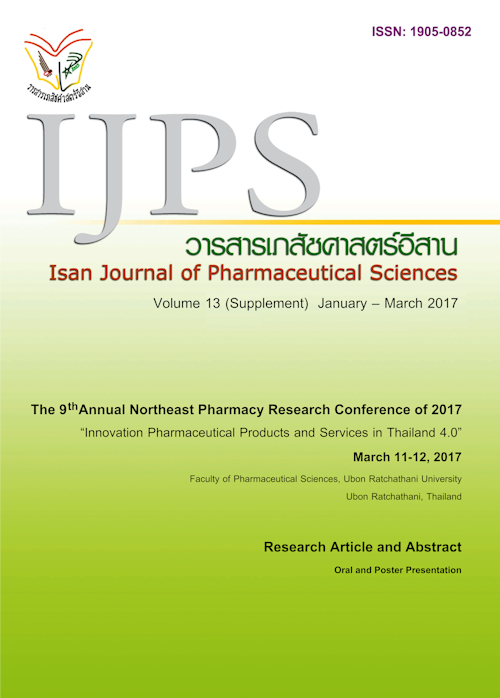Factors affecting INR control and bleeding of warfarin-treated patient, Warinchamrab hospital
Main Article Content
Abstract
Introduction: Warfarin is a narrow therapeutic index drug which is needed a monitor to maintain INR within the target range for optimal efficacy and safety. Due to its action could be affected by many factors, INR target is sometimes difficult to control. This analytical, cross-sectional study was designed to determine factors affecting INR control and bleeding in warfarin-treated patients. Methods: Patients who visited the warfarin clinic at Warinchamrab hospital during May 2015 to May 2016 were enrolled. Patient data were collected from medical records including demographic, social history, medical history, and pharmacogenetics testing. Data were analyzed with descriptive statistic and logistic regression analysis. Results: Sixty patients were included into the study. Atrial fibrillation with valvular heart disease was the most indication of warfarin with 46.7%. The INR target for most patients (83.3%) was between 2.0 and 3.0. Percentage of patients achieving TTR over 60% was 36.7%. The results from multivariate logistic regression analysis showed that factor related to TTR under 60% was polypharmacy (OR 50.156, p 0.031). Patient who had bleeding showed that the ratio of female patient compared with male patient were 38.7% and 10.3%, respectively (OR 5.474, p 0.011). The ratio of patient who had bleeding in patient with GFR <60 and >60 mL/min/1.73m2 were 46.7% and 18.6%, respectively (OR 3.828, p 0.033). Conclusion: Polypharmacy was the significant factor related to INR out of target, whereas female and GFR <60 mL/min/1.73m2 could be risk factors for bleeding in patient receiving warfarin. The results could be applied to improve in INR control of warfarin clinic.
Article Details
In the case that some parts are used by others The author must Confirm that obtaining permission to use some of the original authors. And must attach evidence That the permission has been included
References
Ansell J, Hirsh J, Hylek E, Jacobson A, Crowther M, Palareti G. Pharmacology and management of the vitamin K antagonists: American College of Chest Physicians Evidence-Based Clinical Practice Guidelines (8th Edition): CHEST 2008; 133: 160S-98S.
Apostolakis S, Sullivan RM, Olshansky B, Lip GYH. Factors Affecting Quality of Anticoagulation Control Among Patients With Atrial Fibrillation on Warfarin: The SAMe-TT2R2 Score. Chest 2013; 144: 1555-63.
Chartrungsan A, Laksanabunsong P, NimmannitA, Suwanawiboon B, Poungvarin, N Wongkornrat W, et al. Comparison of Temporary Interruption of Warfarin Therapy for 3 and 5 days before Surgery in Thailand: A Randomized Controlled Trial. Siriraj Med J 2013; 65: 69-72
DeoisaresR, and Rojnuckarin P. Prevalence of VKORC1 Single Nucleotide Polymorphism (SNP)w1639 in Thai Adult Patients Who Have INR More Than 4 from Warfarin. J HematolTransfus Med 2010; 20: 113-8.
Giugliano RP, Ruff CT, Braunwald E, Murphy SA, Wiviott SD, Halperin JL, et al. Edoxaban versus warfarin in patients with atrial fibrillation. N Engl J Med 2013 Nov 28; 369: 2093-104.
Granger CB, Alexander JH, McMurray JJ, Lopes RD, Hylek EM, Hanna M, et al. Apixaban versus warfarin in patients with atrial fibrillation. N Engl J Med 2011 Sep 15; 365: 981-92.
Jaspers Focks J, Brouwer MA, Wojdyla DM, Thomas L, Lopes RD, Washam JB, et al. Polypharmacy and effects of apixaban versus warfarin in patients with atrial fibrillation: post hoc analysis of the ARISTOTLE trial. BMJ 2016; 353: i2868.
Kuanprasert S, Dettrairat S, Palacajornsuk P, Kunachiwa W, Phrommintikul A. Prevalence of CYP2C9 and VKORC1Mutation in Patients with Valvular Heart Disease in Northern Thailand. J Med Assoc Thai 2009; 92: 1597-601
Limdi NA, Beasley TM, Baird MF, Goldstein JA, McGwin G, Arnett DK, et al. Kidney function influences warfarin responsiveness and hemorrhagic complications. J Am Soc Nephrol 2009; 20: 912-21.
Nieuwlaat R, Connolly BJ, Hubers LM, Cuddy SM, Eikelboom JW, Yusuf S, et al. Quality of individual INR control and the risk of stroke and bleeding events in atrial fibrillation patients: A nested case control analysis of the ACTIVE W study. Thrombosis Research 2012; 129: 715-9.
Patel MR, Mahaffey KW, Garg J, Pan G, Singer DE, Hacke W, et al. Rivaroxaban versus warfarin in nonvalvular atrial fibrillation. N Engl J Med 2011; 365: 883-91.
Suwanawiboon B, Kongtim P, Chinthammitr Y, Ruchutrakool T, Wanachiwanawin W. The efficacy of 3-mg warfarin initiating dose in adult Thai patients, who required long-term anticoagulant therapy. J Med Assoc Thai 2011;94 Suppl 1: S225-31.
ThaiSNP2 [Internet]. Biostatistics and Informatics Laboratory, Genome Institute, BIOTEC, NSTDA, Thailand [cited 2017 Jan 31]. Available from: http://www4a.biotec.or.th/thaisnp2/.
Trusler M. Well-managed warfarin is superior to NOACs. Can Fam Physician 2015; 61: 23-4.
Van Den Ham HA, Klungel OH, Leufkens HGM, Van Staa TP. The patterns of anticoagulation control and the risk of stroke, bleeding and mortality in patients with non-valvular atrial fibrillation. Journal of Thrombosis and Haemostasis 2013; 11: 107-15.
Zapata-Wainberg G, Ximénez-Carrillo Rico Á, Benavente Fernández L, Masjuan Vallejo J, Gállego Culleré J, Freijó Guerrero Mdel M, et al. Epidemiology of Intracranial Haemorrhages Associated with Vitamin K Antagonist Oral Anticoagulants in Spain: TAC Registry. IntervNeurol 2015; 4: 52-8.


